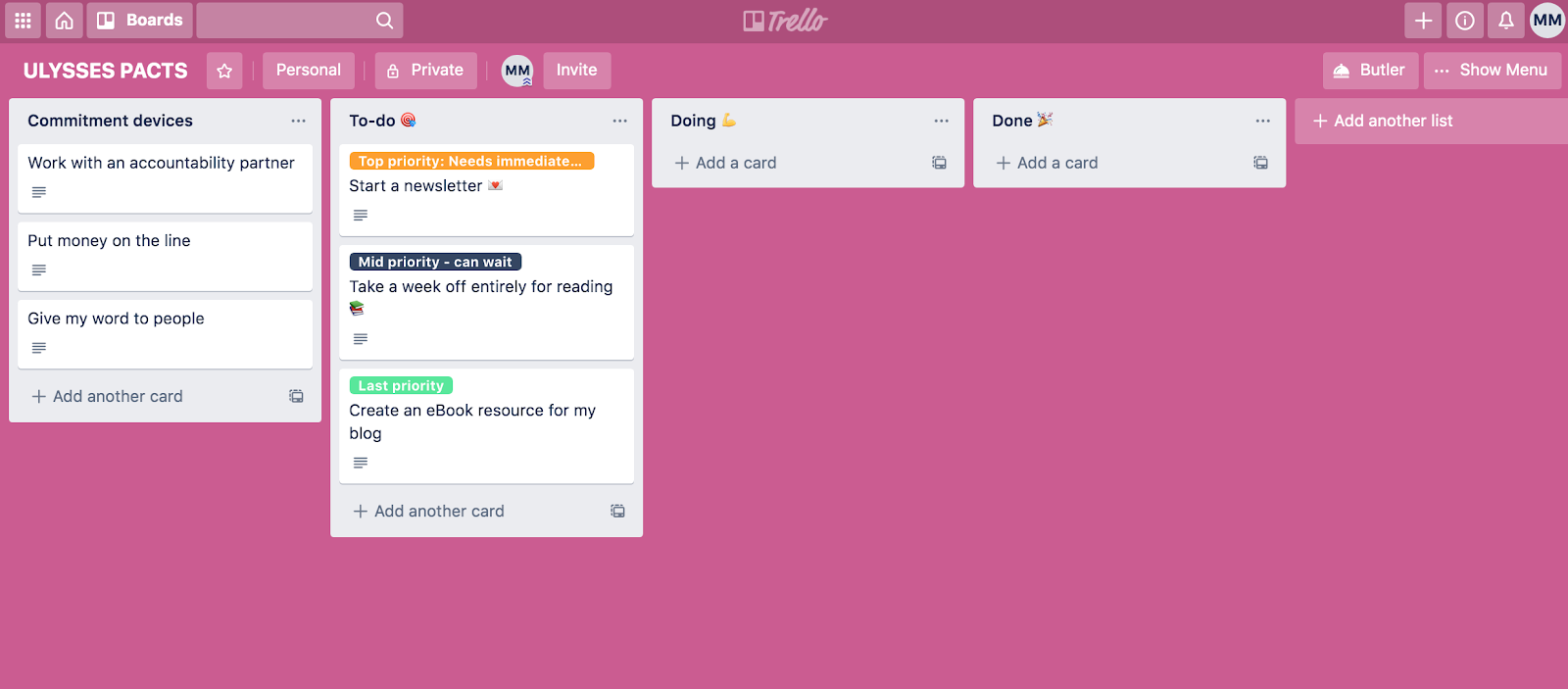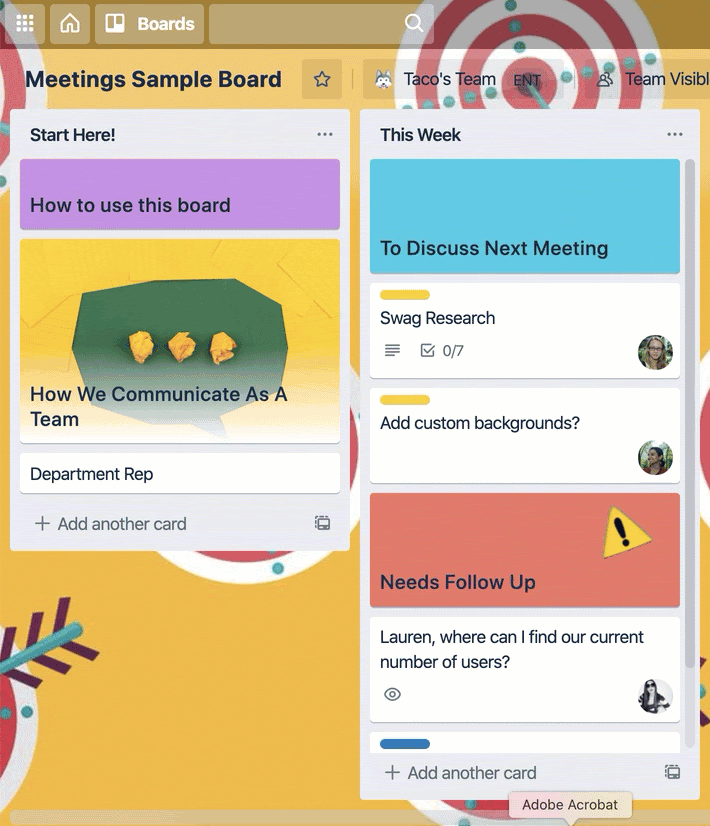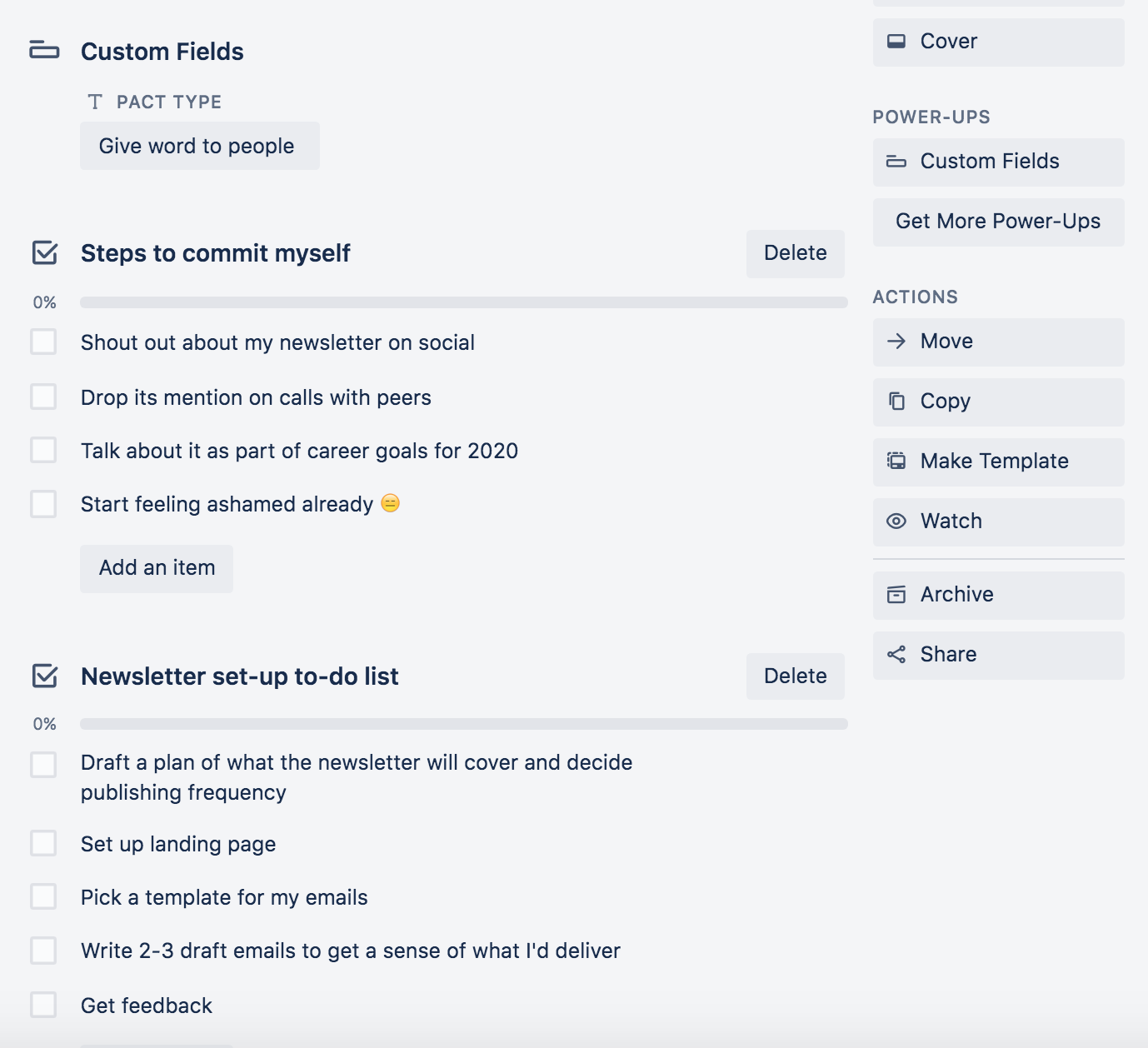On his way back home from the Trojan war, the legendary hero, Ulysses came across the beautiful sirens whose enchanting songs bewitched sailors to jump off their ships into the depths of the ocean. To stop himself and his crew from this unfortunate fate, he made a pact with himself.
He asked his mates to tie him to the ship’s mast long before they crossed paths with the sirens and told them to plug their ears with beeswax. Did it work? You bet it did. This story in the epic poem, The Odyssey, by Homer reveals this is how Ulysses became the first man to listen to the sirens’ melodies and survive their evil-bidding.

But how does this ancient story relate to your modern to-do list and goal setting? You see, like Ulysses, you can also make a pact to accomplish tasks that you’ve been putting off and prevent yourself from succumbing to the evil plot that procrastination hatches.
Not by tying yourself to a mast though! Instead, by tying yourself to a much gentler plan—one that you make long before the procrastination siren shows up and sings its comforting melodies.
For example, try paying for a professional development workshop well in advance of when it’s scheduled. This way, you’re bound to attend since you’ve already paid for it, and getting a refund will only add more work to your plate.
See, it’s not that difficult, is it? Let’s dive into more details of how the Ulysses pact—also known as a commitment device—works and how you can use it to beat that ever-present pull of procrastination.
What Is A Ulysses Pact?
Truth be told: you make lots of plans and goals, only to (unintentionally) let them wither away in your to-do lists. For instance, I have a newsletter to start and I understand how important it is for my business, but have I started on it? Sadly, no. I’ll bet you can relate.
Podia’s Chief Marketing Officer, Len Markidan, sailed the same ship—he wanted to create a course but he dilly-dallied for months. He shares: “Tired of the mental weight of seeing it on my to-do list, I decided to write the sales copy first, and then launched the course with a start date a couple months into the future. Needless to say, when $120,679 in sales rolled in, I somehow found the motivation to get it done.”
Do you see what happened there? Len used a commitment device—writing the sales copy first —and forced himself to meet his goal. Once the money started pouring in, he was motivated enough to overcome procrastination.
This is exactly what a Ulysses pact is—a plan that binds you to a future action by locking your actions in the present when you’re thinking clearly about the goal’s merits.
An interesting Harvard Business Review study on StickK, a startup that assists people in making contracts with themselves, confirms how effective such pacts are. According to the study, the company witnessed a 42.7% success rate for contracts without any stakes. But, for contracts with stakes? Wait for it… the success rate almost doubled to 82.8%! Moreover, if folks opted for a contract that submitted their money to a charity they disliked when they didn’t meet a target goal, the success rate hit 87.1%.
The thing is, your brain loves instant rewards thanks to those motivational shots of dopamine, the feel-good neurotransmitter. You can give yourself that rewarding feeling by checking off routine tasks from your list.
For heavy-duty tasks that are long term, the reward is far less instant. You may not even see the benefit until long after having completed the task. So, your brain tends to shove tasks like these further down on your priority list.
And try as you might, it’s challenging to beat this temptation for immediate rewards. Research from Princeton University explains that there are two parts of the brain involved in decision-making: the emotional part that craves immediate rewards and the rational part that speaks logic. When you’re deciding what to do or working on getting started on a goal, both these parts fight for domination. Most often, however, your emotional brain wins—by making most decisions or, at least, playing a part in the decisions that the rational brain makes. The odds are even higher for your emotional brain to take control when you’re hungry, angry, lonely, tired, or a combination of them all. We’ve all done things we aren’t proud of while feeling hangry.
If you correlate this to your goals, you’ll see that your emotional brain is hard at work, convincing you to give up on tasks that don’t reward you instantaneously.
How Does A Commitment Device Help Lock In Your Plans?
With a commitment device in place, you’re less likely to cave. But why? Three reasons explain the effectiveness of this personal pact:
1. There’s An Incentive On The Line
This could be your money or anything else you choose to put at stake to serve as a motivation trigger. However, remember that “we all have different motivation triggers,” notes Markidan. So, what worked for your coworker might not work for you. “But if you understand your motivation trigger, then you can use this framework to reach just about any goal.”
For instance, Tulane University’s Janet Schwartz led a study with regular users of Discovery Health’s credit cards. The bank would give users a monthly 25% bonus back depending on how much healthy food the cardholders purchased.
However, Schwartz and her team added a twist: they asked participants to increase their expenditure on healthy foods by 5%. The experimental group was tied to a contract—an incentive of sorts.
According to it, the group participants were either supposed to increase spending on healthy foods by 5% and get the bonus or forfeit the entire bonus if they didn’t hit the goal in a given month.
Guess who succeeded in buying more healthy foods? The group that went in Ulysses style—with a monetary contract and a strong incentive to increase their spending.
2. Saying ‘No’ Takes Effort
With a commitment pact in place, putting off task takes work. For instance, if you’re anything like Farzad Rashidi, Visme’s Director of Marketing and Co-Founder of Respona, you book your travel tickets and hotels well in advance. This way, Farzad says, “I feel the obligation to follow through since normally I tend to push back my time off due to my work schedule.”
Without this early booking pact in place, it’d be easy to postpone vacations. With it though, postponing your vacation would be a hassle in itself since you’d have to call several places to cancel bookings. So, you might as well go on that trip.

3. There’s (Often) Accountability Involved
When you’re on your own, “it’s easy to let yourself push things down the road. But when others are expecting you to do the work,” Markidan says, you’re more likely to push through and get it done.
Jory MacKay, RescueTime’s Content Marketing Manager, who created a trailer for his 16-part video course and pre sold it as his commitment device adds:
“While it’s easy to ignore your own expectations of yourself (i.e. deadlines), it’s much harder to ignore when other people have a clear expectation of what you’re going to accomplish.”
The American Society of Training Development has the shiny numbers to prove how accountability gets you rolling in the right direction. According to their study, planning your goal results in a 50% success rate. However, making a commitment with someone else increases this rate up to 65%.
But here’s the interesting bit—drum rolls, please—setting an accountability meeting with the one you set your goals with takes the odds of success to a marvelous 95%! Talk about the power of accountability.
5 Steps To Put The Ulysses Pact Into Action With Trello
This won’t be tough if you lay everything out on a Trello board. Take one step at a time (luckily, beeswax in your ears is not necessary):
1. Prepare Your Trello Commitment Board
Start with creating a Trello board that’ll house all your goals and Ulysses pacts. In typical Kanban fashion, add three columns: to-do, doing, and done.
Since understanding your motivational triggers can take some trial and error, I suggest you also prepare a fourth column titled ‘commitment devices to try’ and add cards with different pacts to bind yourself in. If you’re sure about what would fuel your motivation, feel free to skip this part.

2. List The Goals That Have Been Occupying Your To-Do List For Way Too Long
For me, that’s starting a newsletter. And you? Give it some thought. Then list each goal in a separate card in your to-do column.
Don’t forget to add the details, pointing out exactly what’s stopping you from accomplishing a specific goal in the card’s description so you can get rid of the hiccup(s). Is the goal challenging to execute? Or, is it that you don’t know how to take the first step?
Write it all down (Psst. You’re 42% more likely to achieve a goal when you write it down).

If your board gets busy with lots of cards, you can easily visualize which cards have been sitting untouched for too long with the Card Aging Power-Up. By enabling this feature, cards will visibly age with inactivity.
There are two modes: “Regular” and “Pirate”. In regular mode, cards become progressively more transparent and “fade out” the longer they remain untouched.
In pirate mode, cards will tear, get dark, and crack like an old pirate map.

3. Shortlist The Goals You Want To Commit To
This is important. It’s not useful to draft tons of pacts for all of your goals. This would result in both small and big goals competing for your mind’s energy, and honestly sounds pretty overwhelming. So prioritize the most important goals and commit to them.
To prioritize each goal, use Labels in Trello. Open each card and select Labels from the right side. Using the pen icon beside the colored rectangle, personalize your labels and add one (or more, if you like) to each goal.

If you find you still have a lot of goals to hit and they’re cluttering your to-do list, create another column and call it ‘goals backlog’ where you can add goals you’d like to accomplish in the future.
Take things one step further by using Card Covers and Colors—a great way to style your Trello board, making things even more visual and organized.
In addition to being able to upload your own images as card covers, you can select a card cover from the vast pool that is the Unsplash Gallery (just like when you’re picking the perfect board background!).

4. Decide How You’d Commit To Your Top Priority Goals
Like we talked about above, if you’re only just getting a feel for various motivation triggers, I suggest you pick one from the commitment device column you created. How? Enter: Custom Fields Power-Up.
To enable it:
- Go to your board’s Menu and select Power-Ups.
- Type in Custom Fields in the search box and select Add.
- Choose Edit Power-Up Settings to create a ‘Text’ custom field.
- Title this ‘Pact type’ or ‘Motivation trigger’ to remind yourself how you’re going to execute your plan

5. Finally, Lay Out A Plan
Next, lay out the steps you need to take using the Checklist option in your card. This helps divide your goal into action steps.

The best part? You can add dates to each step in your checklist using Advanced Checklist. If you have the Calendar Power-Up enabled on your board, you can see additional due dates on your checklist in this view so you never miss a milestone on your way to achieving your big goals.
If you plan to commit with an accountability partner, add them to your Trello board using the Invite option on your board.
Achieve Your Goals And Fight Off Those Temptations—The Ulysses Way
Ready to commit yourself to goals that have been sitting at the bottom of your task list for way too long? Try binding yourself in a commitment pact and see how it works for you. Choosing the right motivational trigger can take you to the finish line in no time.
So, whether it’s mortal fate, money on the line, or a friend’s watchful eye that motivates you, one thing’s for sure—your to-do list will shrink thanks to Ulysses and his legendary pact.
Good or bad, we’d love to hear your thoughts. Find us on Twitter (@trello)!










































